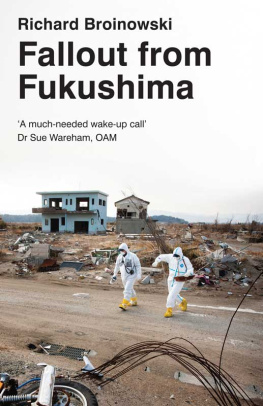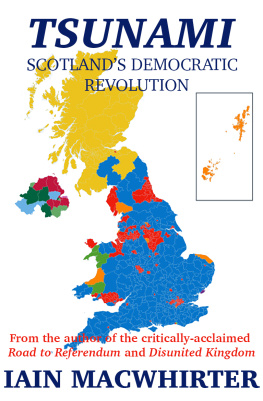Japan after 3/11
JAPAN
AFTER 3/11
Global Perspectives on the Earthquake, Tsunami, and Fukushima Meltdown
Edited by
Pradyumna P. Karan
and
Unryu Suganuma
Cartography by Richard Gilbreath

Due to variations in the technical specifications of different electronic reading devices, some elements of this ebook may not appear as they do in the print edition. Readers are encouraged to experiment with user settings for optimum results.
Copyright 2016 by The University Press of Kentucky
Scholarly publisher for the Commonwealth, serving Bellarmine University, Berea College, Centre College of Kentucky, Eastern Kentucky University, The Filson Historical Society, Georgetown College, Kentucky Historical Society, Kentucky State University, Morehead State University, Murray State University, Northern Kentucky University, Transylvania University, University of Kentucky, University of Louisville, and Western Kentucky University.
All rights reserved.
Editorial and Sales Offices: The University Press of Kentucky 663 South Limestone Street, Lexington, Kentucky 405084008 www.kentuckypress.com
Cover calligraphy by Toyoshi Satoh.
Cataloging-in-Publication data is available from the Library of Congress.
ISBN 978-0-8131-6730-5 (hardcover : alk. paper)
ISBN 978-0-8131-6731-2 (epub)
ISBN 978-0-8131-6732-9 (pdf)
This book is printed on acid-free paper meeting the requirements of the American National Standard for Permanence in Paper for Printed Library Materials.

Manufactured in the United States of America.

| Member of the Association of
American University Presses |
Contents
Pradyumna P. Karan, University of Kentucky
Unryu Suganuma, J. F. Oberlin University
Junko Oikawa, J. F. Oberlin University
Yukiko Dejima, J. F. Oberlin University
Masatomo Umitsu, Nara University
Takehiko Takano, Tohoku Gakuin University
H. Todd Stradford, University of Wisconsin-Platteville
Tomoko Yamazaki, Iwate University
Ryohei Sekine, Tohoku University
Jonathan Taylor, California State University, Fullerton
Unryu Suganuma, J. F. Oberlin University
Toshio Hatsuzawa, Fukushima University, and Takehiko Takano, Tohoku Gakuin University
Yukio Yotsumoto and Shunichi Takekawa, Ritsumeikan Asia Pacific University
Yukiko Dejima, J. F. Oberlin University, and Wakako Ikeda-Ohtsubo, Tohoku University
Toshikazu Seto, Ritsumeikan University, and Yuichiro Nishimura, Nara Womens University
Jun Tsuchiya, Miyagi Gakuin Womens University
Masateru Hino, Tohoku University
Kenji Yamazaki, Meiji University
James M. Hall, Iwate University, and Moto Suzuki, All Hands Volunteers
Kohei Okamoto, Nagoya University, and Kumi Sato, Kinjo Gakuin University
Yilin Hou, Syracuse University, and Unryu Suganuma, J. F. Oberlin University
Lisa Yinghong Li, J. F. Oberlin University
Christine Mary Wilby, J. F. Oberlin University
Pradyumna P. Karan, University of Kentucky
Figures
Preface
On March 11, 2011, a massive tsunami triggered by an underwater earthquake pummeled the Pacific coast of Tohoku. The aftermath was overwhelming: ships could be spotted miles inland; cars floated in the ocean; more than 16,500 died or were missing; relief organizations struggled to reach affected areas to provide aid for survivors and those evacuated from areas contaminated by nuclear meltdown. Efforts to contain radiation from the damaged nuclear power plant were not successful.
Shortly after the disaster, an international group of social and natural scientists from Japan and abroad traveled to Tohokus most devastated areas, observing and documenting the tsunamis impact. The results of their research were presented at a symposium sponsored by the Institute for International Studies at J. F. Oberlin University, Tokyo. This volume contains revised versions of those papers, which offer field-based analysis of the triple disasters environmental, economic, and social impacts as well as the response and recovery efforts. The papers incorporate all four phases of disaster management: mitigation, preparedness, response, and recovery. Located at the intersection of geography, history, anthropology, sociology, political science, and disaster literature, the papers offer a vibrant and conceptually diverse inquiry into the rapidly evolving field of disaster study within the social sciences.
With contributions from over twenty-five scholars from the United States, Japan, Britain, and New Zealand, the volume presents a general view of mitigation, damage, recovery, and reconstruction, and it aims to advance both ongoing and emerging debates on disaster mitigation and the future of nuclear energy. By presenting a comprehensive and authoritative examination of one of the worlds major natural disasters and the resulting nuclear catastrophe, it will serve as an invaluable resource for students and scholars, and chart new agendas for research, policies, and activism.
Remarks by the Honorable Itsunori Onodera, Member of the Japanese House of Representatives from Kesennuma, Miyagi Prefecture
Translated by Mihoko Inamori
Kesennuma City, Miyagi Prefecture, one of the areas most seriously impacted by the Sanriku tsunami in Japan in 2011, is my hometown. Japan has the best tsunami warning system in the world; however, the warning system did not save many lives in Kesennuma City. One of the major causes for the huge disaster on March 11 was human error. Unfortunately, the Meteorological Agency ignored correct data sent by the tsunami warning system. The governmental agency predicted that the tsunami would be between three and six meters; the local government made decisions based on the erroneous Meteorological Agency report. As a result, many residents evacuated to the rooftops of three-story buildings, which could survive a six-meter tsunami. In fact, the tsunami that struck Kesennuma was sixteen meters, which totally wiped out most buildings in the town, including my own office.
The second major error involved the interval between the tsunami warning and the arrival of the tsunami, which was about forty minutes. Many residents evacuated to the hills or high ground and mistakenly assumed either that no tsunami had materialized or that it had already reached shore. Based on the governments warning of a three- to six-meter tsunami, many residents decided to return to their houses to collect their belongings. Subsequently, a sixteen-meter tsunami struck the city. An oil tank was dislodged and caused a big fire in the town. Because of the destruction, it is no longer possible to distinguish the location of our houses or office buildings. Many survivors were isolated for a few days without any help. Because the temperature in the city around March was below the freezing point, many survivors on the rooftops of buildings froze to death. Food and blankets were necessary, but in short supply.
The scale of the March 11 tragedy and the 1995 Hanshin-Awaji earthquake was totally different. In the aftermath of the Hanshin earthquake, efforts focused on recovery of the city, but in the case of the 2011 tsunami, it is also necessary to focus on the recovery of the fishery industry, which is the major industry in Kesennuma. For over two and a half months, infrastructure was essentially nonfunctional. Fishery products could not be processed because of the lack of water. The so-called invisible recovery, such as repair of water pipes, takes much longer than the visible recovery of the citys appearance. Moreover, government red tape has made recovery difficult. For instance, the ground in Kesennuma subsided because of the earthquake; however, residents must fix this problem by themselves according to the current law. There is no way that the tsunami victims can afford the necessary landfill by themselves. Also, misuse of recovery funds has been discovered. The 19-trillion-yen budget from the recovery fund has been used to buy weapons and rebuild a football stadium in Tokyo. These projects have nothing to do with disaster recovery or the victims of the March 11 tragedy.
Next page







